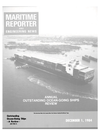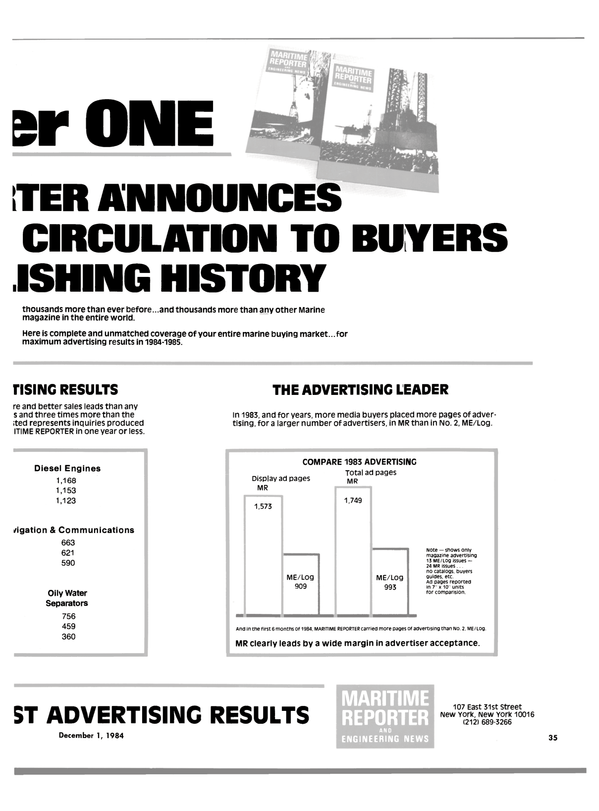
Corpus Christi Bulk-Loading Facility To Be Modernized
The Port Commission of the Port of Corpus Christi (Texas) Authority recently approved funds for modernization of its existing bulk materials dock. The existing facility includes a bucket type unloader that is also used for loading vessels calling at the port. The Port Commission recognized that a more efficient loadout system would better serve the present users of the facility as well as prospective users.
The Commission retained Soros Associates, a New York-based international consulting engineering firm specializing in the planning, design, and construction management of ports, offshore terminals, and bulk material-handling systems, to provide the engineering and construction supervision for the modernization program. Soros, working closely with the Port's staff, developed various concepts that considered means to reduce ship turnaround time, increase operating efficiency, and construct a new loadout facility without disrupting the present operations.
The concept selected provides for a new loadout facility to be located west of the existing unloading dock.
A new berth able to accommodate vessels ranging from 1,500-ton barges to 100,000-dwt ships will be constructed with three breasting dolphins and two mooring dolphins along the length of the channel. A radial type Sumitomo shiploader, mounted on a curved rail in front and turntable in the rear, will have the capability to move along the length of a vessel at berth, as well as raise, lower, and shuttle the boom conveyor in and out from the bulk- head line. These shiploader movements will permit loading of most vessels without the need to move the ship at the berth.
The shiploader will be fed by a 48-inch-wide belt conveyor system designed to handle 1,500 tons per hours of material weighing 55 pounds per cubic foot. The conveyor system will be fed at multiple points along its length—at two points in the existing stockpile area and at a combination truck/railroad car dumping pit located adjacent to the existing railroad yard.
The pit dump, enclosed in a building, can accommodate a 100- ton, bottom-dump railroad car or three 20-ton trucks that rear-dump through openings in the side of the building. These openings will be closed with overhead doors when dumping from railroad cars. An overhead type, trolley-mounted railroad car shakeout will be provided to speed up railcar unloading.
Material discharged into the dump hopper is fed onto the belt conveyor system by four variable-rate, vibrating pan feeders located under the openings in the bottom of the hoppers.
The belt conveyor system will be protected from damage by tramp iron by a suspended magnet and a metal detector. An in-motion belt scale to record tonnage loaded into ships will be provided to assist in the shiploading operation.
In order to meet the standards of the Texas Air Control Board, the facility will be constructed with a dual dust control system. This system will consist of dust suppression for bulk materials such as coal and petroleum coke that can be sprayed with water, and containment for bulk materials that cannot be sprayed with water. All conveyor transfers will be fully enclosed, and all ground conveyors will be provided with hood covers. Return belt scrapers and plows will be designed and installed to minimize any carryback of material on the return strand of the belt.
Dust collection during the shiploading operation is in two modes.
In the first mode, the loading spout, inside a flexible concentric air duct, is lowered into the ship's hold with the discharge end of the spout and the air duct located in close proximity to the discharged material. The dust-laden air generated at the discharge is drawn into the duct at approximately one-half (17,500 cfm) of the rated capacity of the dust-collection system. The spout and duct are raised simultaneously as the material is discharged into the ship's hold.
In the second mode, a trimming spoon located at the discharge end of the spout is used to throw material under the vessel's hatch coamings.
This operation generates more dust. Therefore, the dust is contained in the hold by strip tarps, and is exhausted from the hold through the concentric duct that is raised independently of the spout and spoon and positioned over the openings in the tarps. In this mode, the full air volume of the system (35,000 cfm) is utilized to capture the airborne dust in the hold.
This type of shiploader dust-collection system was also designed by Soros Associates for the new shiploader at the Port of Houston, as well as at Arco Petroleum Products Company's coke-loading facility at the Port of Longview, Wash.
The Port of Corpus Christi recognized the need to expand the new facility in the future without having to shut down the operation. Therefore, the design incorporates space for additional conveyor transfers for both inbound cargoes from rail and truck and outbound cargoes from areas on the site designated for future storage.
Contracts for construction of the new facility were awarded recently to the following contractors: dredging, Lloyd W. Richardson Construction Corporation, Arkansas Pass, Texas; shiploader, Sumitomo Heavy Industries Ltd., Japan; mechanical/ electrical, SCE Incorporated, Birmingham, Ala.; and civil/marine, Paragon Engineers and Constructors, Inc., Houston.
The Corpus Christi facility is scheduled for start-up during the last quarter of 1985.
Read Corpus Christi Bulk-Loading Facility To Be Modernized in Pdf, Flash or Html5 edition of December 1984 Maritime Reporter
Other stories from December 1984 issue
Content
- Midland Affliated Co. Agrees In Principle To Acquire Federal Barge page: 5
- Webb Elects Officers To Governing Board— Bryan Named President page: 5
- Brown Brothers Appoint New Marketing Director page: 5
- Hyundai's $18-Million Maritime Research Institute In Ulsan Completed page: 6
- Huthnance Corporation Formed To Consolidate Rig Ownership page: 6
- Brochure On Halon 1301 Fire Extinguishing Systems Offered By Walter Kidde page: 6
- Bay Ship Converts NavAids Barge For U.S. Coast Guard page: 6
- Annual Conference Of CSSRA Scheduled For February 18-19, 1985 page: 6
- $425-Million Rig Expansion Program Announced By Sonat page: 7
- Krupp MaK Reports On Sales Of M 5 5 1 / M 5 52 Series Diesel Engines page: 7
- Lindenau Yard Delivers Seismic Research Vessel To Western Geophysical page: 7
- NMEA Plans to Expand Electronics Technician Certification Program page: 7
- Hose-McCann Introduces Dial Telephone System page: 7
- Peterson Builders Lays Keel For Second Of Three Mine Countermeasure Ships page: 8
- Eastern Marine Delivers Towboat —Ninth of A 10-Vessel Contract page: 8
- USCG License Preparation Quicker And Easier With Computer-Aided System page: 8
- Seebeckwerft Delivers World's Largest Railway/Car Ferry page: 8
- Magnavox Announces First Fully Automatic Vessel Monitoring System page: 8
- Magliocca Elected New General Chairman Of NSC Marine Section page: 9
- BFGoodrich Offers New Brochure On Cutless Line Of Rubber Bearings page: 9
- New Industrial Mixer Seals By EG & G Sealol page: 10
- $2.8-Million Contract To Tacoma Boat Has $97.5-Million Potential page: 10
- Training Success With U.S. Rig Simulator Featured At Conference page: 10
- Borum Wins Kings Point Outstanding Professional Achievement Award page: 10
- Desco Marine Chosen To Build 107-Foot Steel Fishing Boat page: 11
- Marine Consultants' Society Hears Paper On An Attorney's View page: 11
- Offshore Shipbuilding Delivers Passenger/Vehicle Ferry page: 11
- Exxon Research Offers To License Computerized Machine Analysis System page: 11
- OUTSTANDING OCEANGOING SHIPS OF 1984 page: 12
- Marine Applications Book Availble From Sandusky page: 13
- Avondale Shipyards Holds Keel-Laying Ceremonies For First Of Four Navy Fleet Oilers page: 13
- Robins Named Managing Director-Business Operations At Rolls-Royce page: 13
- Containership 'Merzario Britannia' Launched At Fincantieri Yard page: 14
- N.F. Pergola Appointed Manager-Marine Personnel At Energy Transportation page: 14
- Murray Named Executive Director Of St. John Port Development Commission page: 14
- Regency Introduces The CR5000 Electronic Chart Recorder page: 14
- Operate 365 Days a Year with Greater Efficiency, Safety and Profits page: 15
- K-C Offers Literature On Replacement Parts Line For GM Diesels page: 16
- WABCO Westinghouse Offers Free Booklet On Controls For Ships page: 16
- Crouse-Hinds Offers Literature On Lighting Fixtures & Others Products page: 17
- Ursini Appointed Vice President-General Manager Of Skagit Products page: 17
- The 92nd SNAME Annual Meeting A Special Post-Meeting And Exposition Report page: 18
- Cable Splicing System Lowers Shipbuilding Costs page: 23
- New Literature Available On VHF/FM Marine Radios From Uniden Corporation page: 26
- Hahnfeldt Appointed Power Division Sales Manager At H.O. Penn Machinery page: 26
- Todd-Los Angeles Delivers Guided Missile Frigate FFG-51 Gary To U.S. Navy page: 28
- Ryan-Walsh Appoints John McCarron Jr. Chief Executive Officer page: 28
- Koomey Announces Management Changes—Dumas Named President page: 30
- ASNE Establishes Dr. James A. Lisnyk Memorial Scholarship page: 30
- Navy Awards E-Systems $40-Million Contract page: 30
- Rexnord Announces Formation of Process Controls Division page: 30
- Du Pont's Maintenance Painting Service Lowers Costs On Offshore Platforms page: 32
- Morgan Appointed National Sales Manager For Welded Beam page: 33
- John Gaughan Named To New Maritime Post page: 33
- Taylor Joins COMSAT World Systems Division As Senior Vice President page: 34
- Todd Marine Systems Offers New Brochure On Combustion Technology page: 34
- Torpedo SPC Chosen For Advanced Cable Layer page: 34
- Corpus Christi Bulk-Loading Facility To Be Modernized page: 35
- New Full-Color Brochure Available From PACECO page: 36
- Daewoo Gets $425-Million Contract From Sonat For Six Semisubmersible Rigs page: 36
- Whalen Joins Huthnance As Vice President -Operations page: 36
- Liner Norway Fitted With New MaK-Driven Gensets page: 37
- MarineSafety Offers Radar Renewal Course page: 37
- Crosby Group Adds New Block To Product Line page: 37
- Armco's Baltimore Precision Forging Complex Now In Full Operation page: 38
- Regency Introduces Marine Television/FM Stereo Antenna And Amplifier page: 38
- Newman's Introduces NEWCO Marine Valves page: 38
- Rockwell Offers Brochure On Ship Information Management Systems page: 38
- Markey Delivers DESH-6 Electric Research Winch page: 38
- Surface Effect Ship Margaret Jill Christened In New Orleans page: 40
- Free Jered Brown Brochure Highlights Denny Brown Folding Fin Stabilizers page: 41
- C. Plath Offers Literature On NAVIGLOBE Satellite Navigation Receiver page: 43
- Free Literature Offered On Walter Kidde Marine Smoke Detection System page: 43
- Imperial Survival Suits Offered by Alexander page: 43
- Phoenix Introduces Sodium Fishing Lights page: 43
- MonArk Boat Delivers Fireboat To City Of Memphis page: 44
- Tano Corporation Offers New Brochure On Marine Automation Systems page: 44
- SNAME Announces 1985 Scholarships In Graduate And Undergraduate Levels page: 44
- Moss Point Marine Launches Supply Boat For Argosy Offshore page: 45
- Sea Float Buoys Approved By Norwegian Maritime Directorate page: 45
- Tracor Hydronautics Delivers Part Task Ship-Handling Simulator To Panama Canal Commission page: 46
- New York Section SNAME Meeting Discusses Drydock Certification page: 46
- Bethlehem Steel's Huge Drydock At New Sabine Yard In Texas To Be Operational In Spring '85 page: 47
- New Rudder-Shaft Bearing From Thomson-Gordon page: 47
- One-Day Seminar Discusses Energy-Saving Potential Of A-C Variable Speed Drives For Shipboard Application page: 51
- Dillingham Maritime Delivers Building Modules To Valdez For Transport To North Slope page: 55
- ASEA Hagglunds Establishes New Division For Marketing Cargo Cranes In The U.S. page: 55
- Southwest Marine Awarded Two Contracts Worth $2.8-Million page: 55
- Videoteleconferencing Systems To Be Built By COMSAT General page: 55


